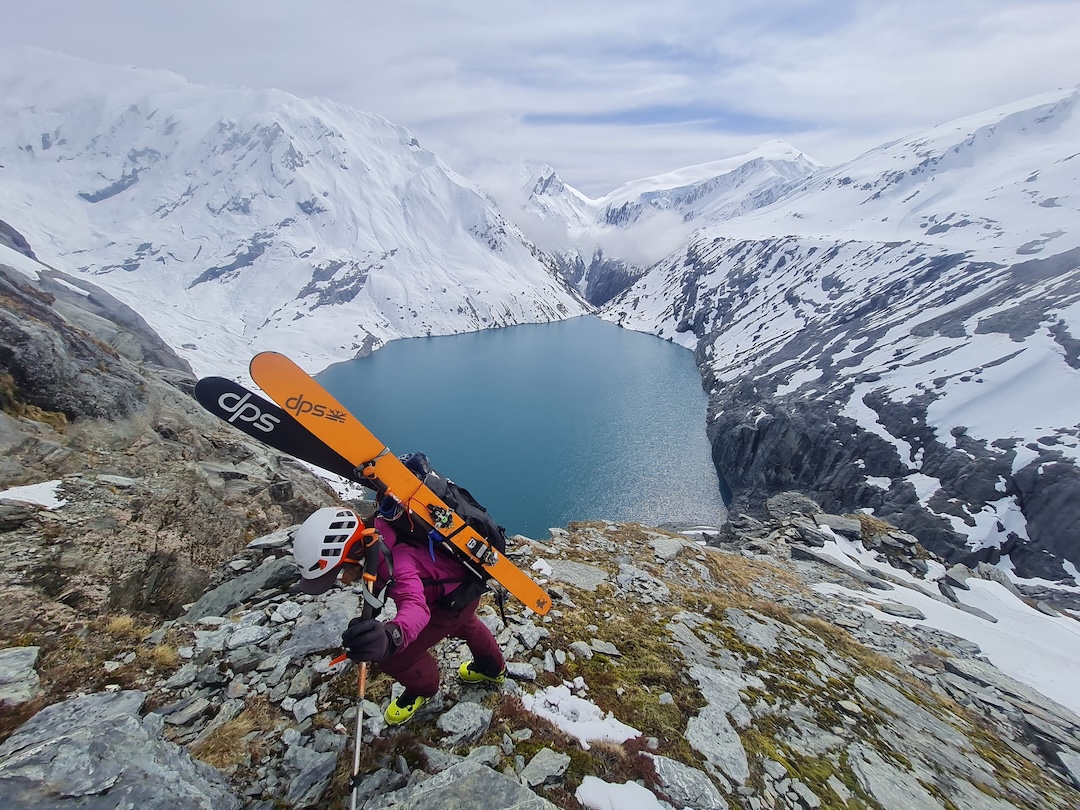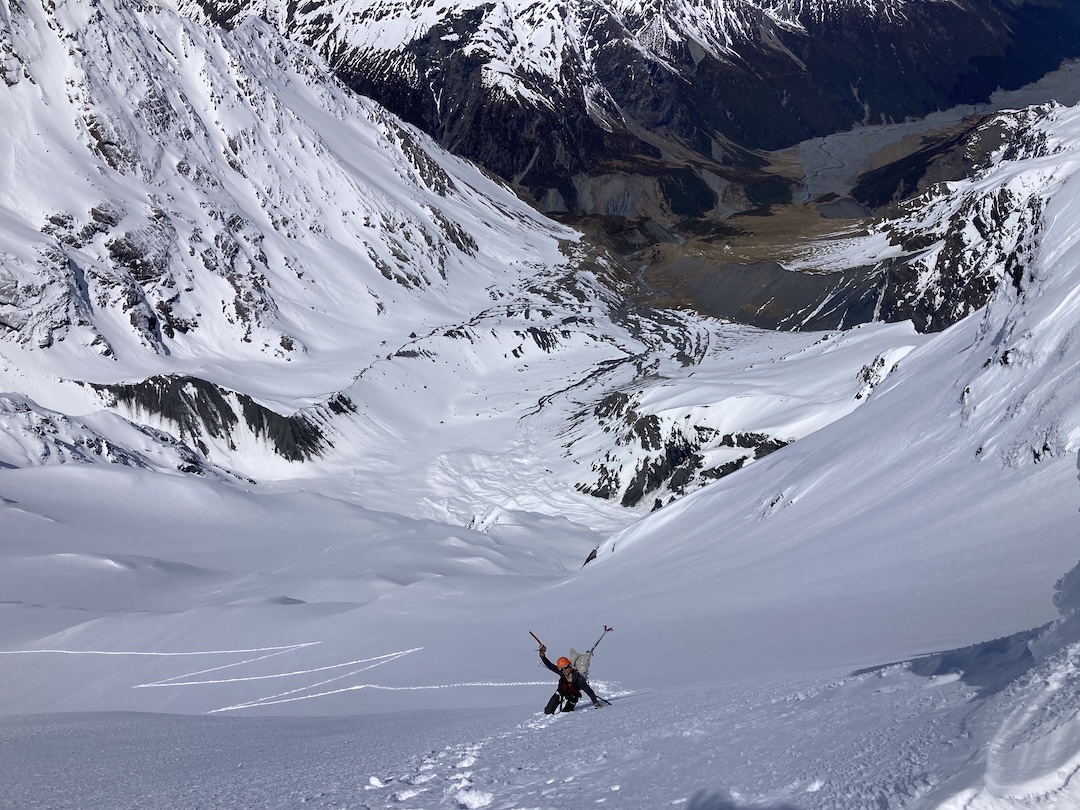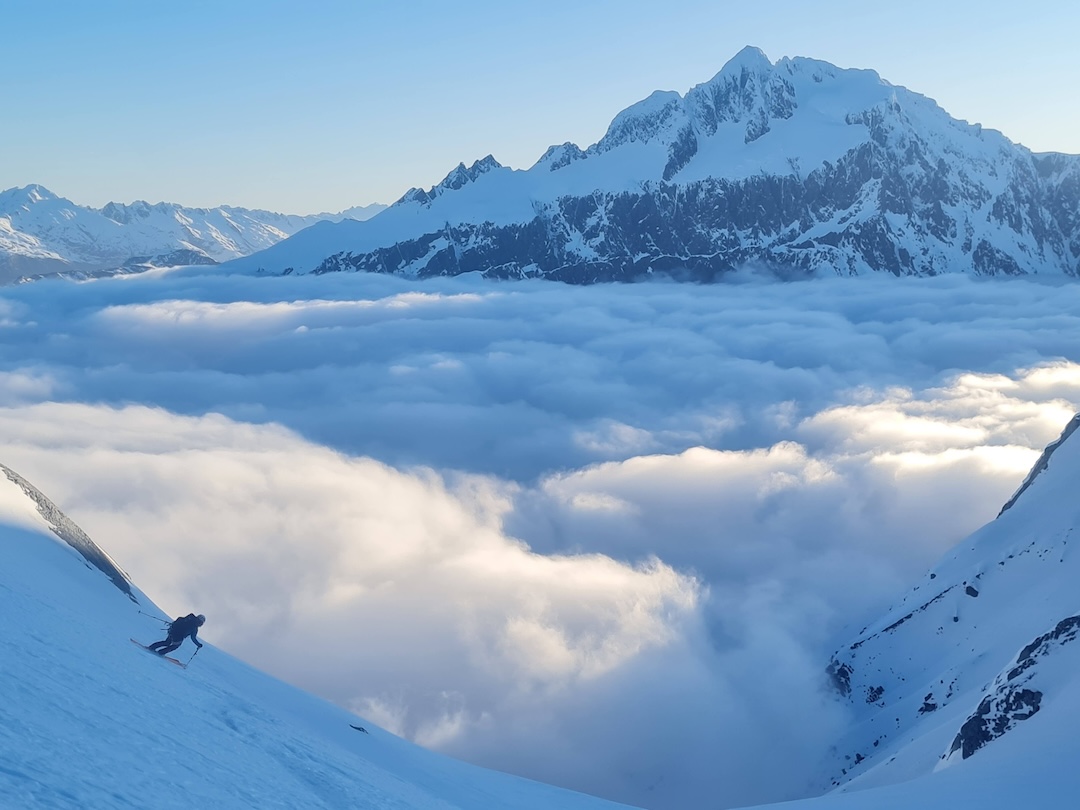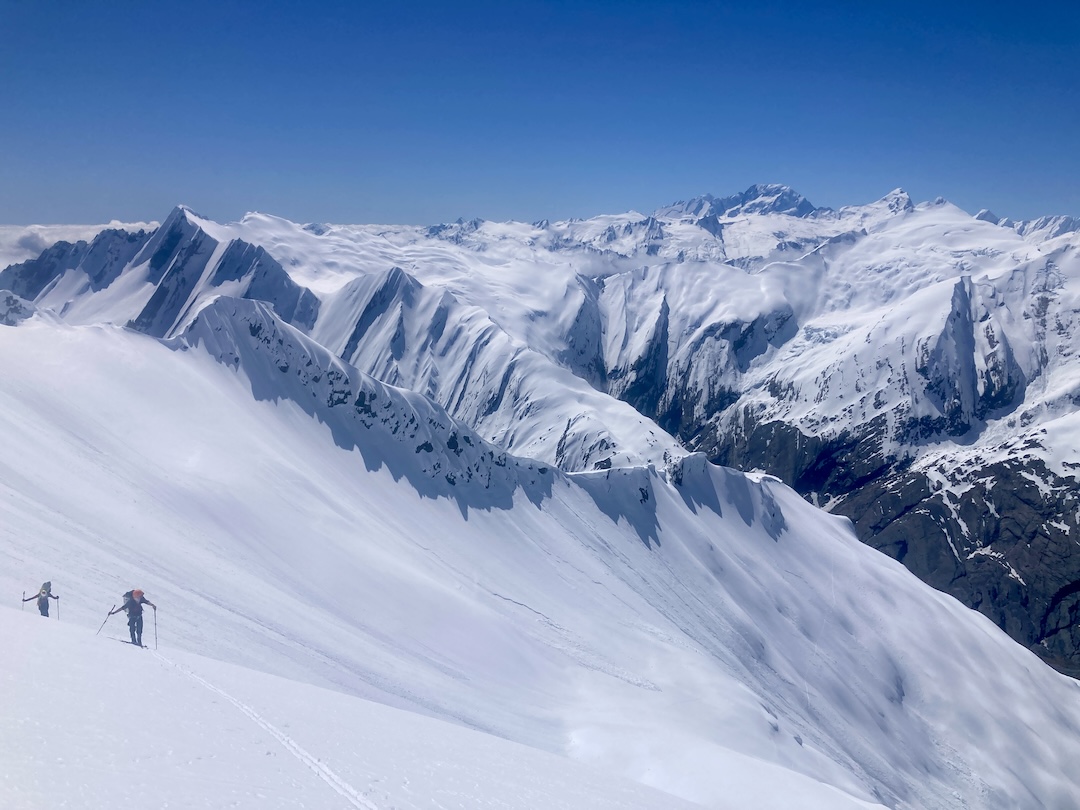Hooker Range: High-Level Ski Traverse
New Zealand, Southern Alps
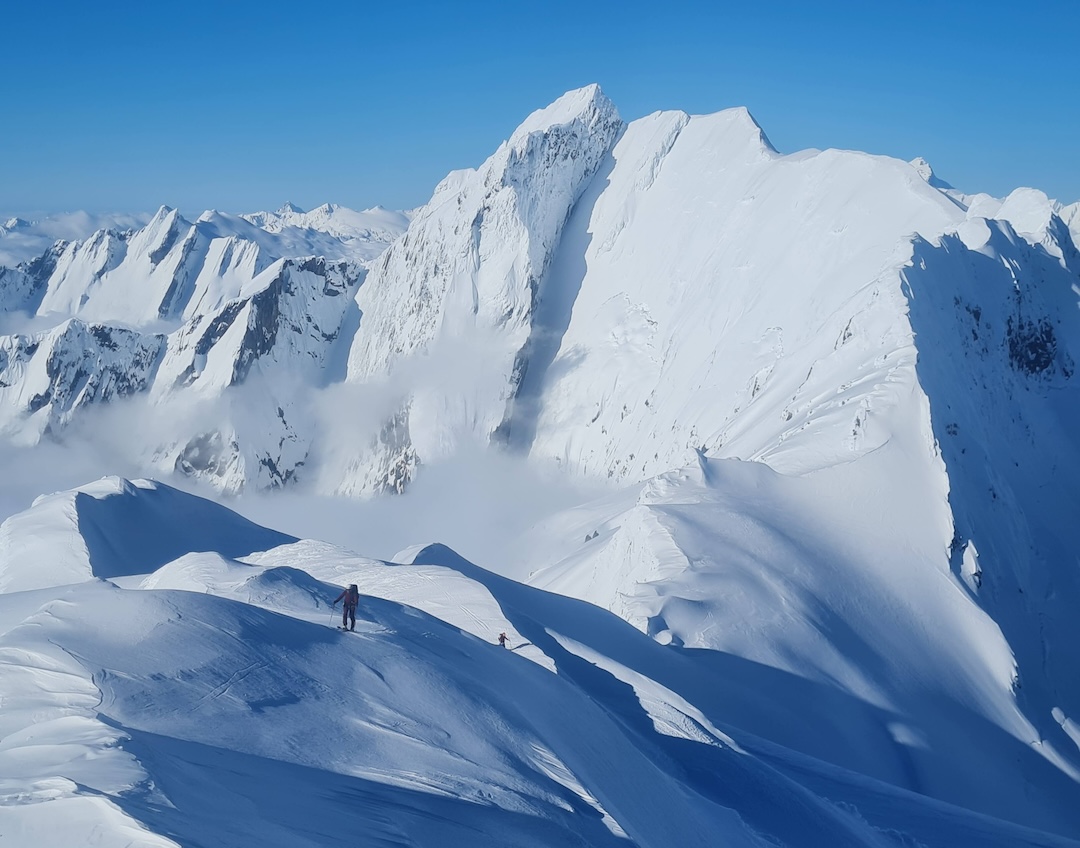
Ruari Macfarlane is visionary when it comes to unclimbed and unskied lines in New Zealand. Our idea for a ski traverse of the Hooker Range was to begin at Aoraki/Mt. Cook and cross the Main Divide at Barron Saddle (1,992m) via the Scissors (2,239m). From there we would drop to the headwaters of the mighty Landsborough River to access the Hooker Range and ski five of its main peaks. The end point would be the Paringa River in South Westland. The total distance would be about 90km, with 11,000m of gain and loss, in very remote country with no easy escape routes.
As far as we knew, the Hooker Range had not been traversed on skis. Access, always challenging in New Zealand’s mountains, would require a five-day clear period in mid to late spring (October) and low snow levels. While the Main Divide is relatively popular for ski descents—especially within Aoraki/Mt. Cook and Westland national parks—ranges west of the Divide are notoriously difficult to access, requiring long climbs or arduous bush-bashing and river crossings if accessed directly from the West Coast.
On October 12, Ruari, Troy Forsyth, and I made a late dash from Mt. Cook Village, climbing 1,000m to Mueller Hut to begin the journey. The next morning, we skied to the south with dust on crust providing a fast descent to the Mueller Glacier. Our first crux was crossing the broad Scissors snow slope on the Main Divide. Ruari set a brilliant track, and eventually we donned crampons to reach the Scissors ridge. We could see the Hooker Range, our ultimate goal, to the west of us, and the snowline was an ideal 1,100m. We dropped into the subalpine for a swim in a glacial lake before crossing the Landsborough River in late afternoon. There, we collected a bucket of extra food that Ruari had stashed in the summer.
Each of our days on this tour began with a long climb back into the alpine in running shoes (often including river crossings). Transitioning back to ski boots provided daily relief.
Townsend Glacier was our first foray onto the Hooker Range. The 600m climb felt arduous with transalpine packs. Unable to traverse the ridge west toward Whitcombe Peak (1,887m) due to an impassable crown wall, we descended 1,000m back to the south, skiing on cooling corn, and walked five minutes to a perfect campsite under a full moon.
The next day, we skinned and cramponed up a steep east-facing ridge next to Whitcombe Creek and the Fettes Glacier, which allowed convoluted access to the Zircon Glacier, and eventually the summit of Fettes Peak (2,451m). A seven-meter crown wall from a glide-slab avalanche was nervously negotiated via a narrow, skiable ledge. The ski off the south side began perfectly and remained so for miles until rockfall crossed our descent couloir to Zora Creek. A small corner and a tiny ice runnel gave passage with aluminum crampons, a 45cm ice hammer, and skis stashed on packs. I inched down this 50m M3 section, trying not to kick out the ice sliver. There were no anchors for rappelling, just muddy shale. We crossed Zora Creek barefoot in the dark and camped immediately.
Day three began with an ascent west to Mueller Pass (1,445m) and on to Mt. Strachan’s (2,561m) northeast ridge. Traversing south from the ridge, we skinned 800m up the Strachan Glacier and cramponed the last 50m to the summit. Another crux awaited: the steep descent west to the Edison Glacier. A rollover hid the terrain below, but a runout was visible via a fast velvet snow surface. We hopped across glide cracks and bergschrunds, then booted, traversed, and skinned southwest to the Strachan-Dechen col. Travel was surprisingly fast on Mt. Dechen’s (2,643m) upper slopes, and we skinned to the summit as the sun set over the Tasman Sea.
We descended to the west and then southwest, dropping 1,650m to the Ōtoko River. The start of this descent, on the vast McCardell Glacier, felt like skiing a volcano. The next 1,000m passed through the Eye Tooth Falls, a wide couloir. Huge schist walls loomed through the jungle mist on either side as we skied into endless and complex avalanche debris. We hit the river flats at 900m just as it got dark.
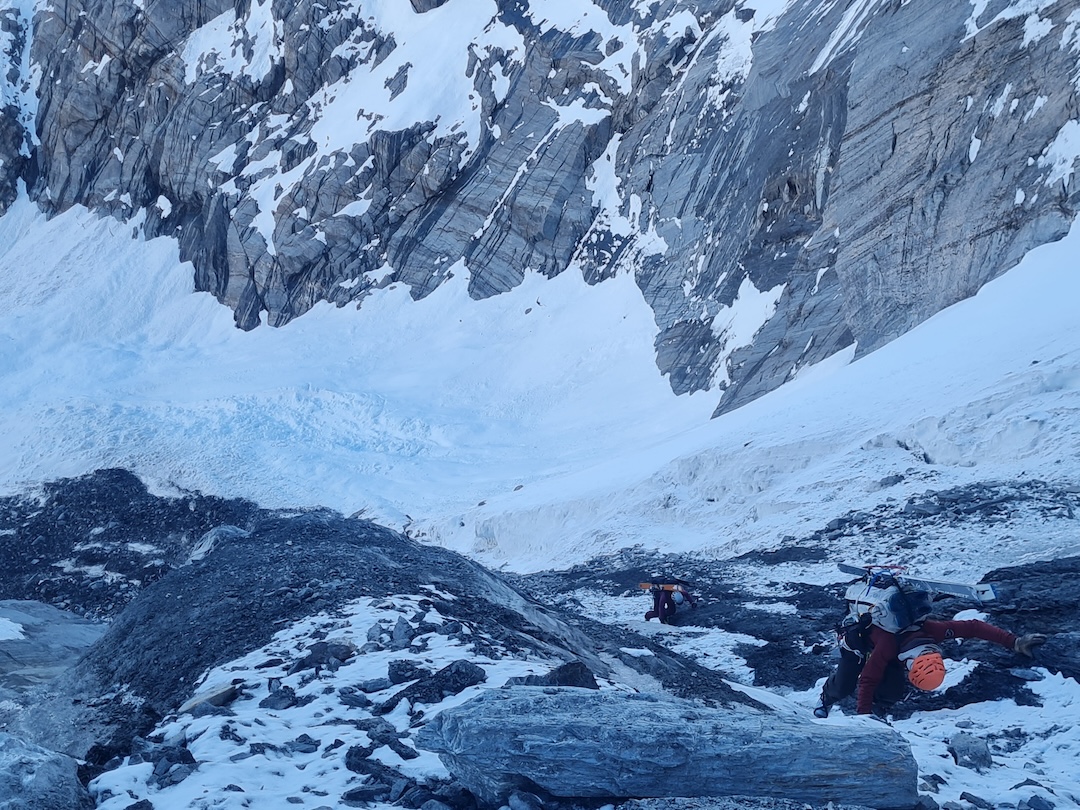
On day four, the initial scramble south and upriver to Lower Ōtoko Pass went smoothly—one of us scrambled to the top of a schist boulder and hauled up all the packs, taking care not to tangle our skis in the subalpine scrub. There was a committing river jump and steep cramponing to reach Mt. Hooker’s east ridge, and a steep, flat-light couloir to ski into the Hooker Glacier.
After a nine-hour ascent, we stashed our overnight gear in a hole before the final 500m skin and crampon up Mt. Hooker (2,640m). Thick rime coated the summit rocks. We almost circumnavigated the peak to reach the mountain’s northwest side, then Ruari launched into the final 50m of steep rime to the top; Troy and I opted to skip it, feeling less comfortable climbing this terrain with one stumpy ice tool. We descended a steep couloir southwest to another subalpine camp in upper Murdock Creek.
On day five, a weak northerly system arrived, which meant no visibility for our planned direct line down the west side of Mt. McCullaugh (2,226m), which we summited from the southeast. Instead, we traversed south around the peak by GPS and booted east over the Buttress (1,870m) to Tunnel Creek’s west side. Eventually, we emerged soggy through the clouds and into a green and gold world.
After a comfortable night under a great rock slab at the bush line, we rallied southwest down a steep, forested ridge to Tunnel Creek Hut and spent a night there. On day seven, we hiked for two hours to meet a jet boat at the Paringa-Ōtoko river junction for a fast exit to the West Coast highway. Ruari, ever the purist, walked the whole way.
—Anna Keeling, New Zealand


